| Revision as of 01:30, 22 February 2013 editAddbot (talk | contribs)Bots2,838,809 editsm Bot: Migrating 33 interwiki links, now provided by Wikidata on d:q204472 (Report Errors)← Previous edit | Revision as of 03:36, 22 February 2013 edit undoDbiel (talk | contribs)Rollbackers10,568 edits removing the one remaining interwiki link (per Wikidata) after adding it to WikidataTag: Removal of all interwiki links; Wikidata is liveNext edit → | ||
| Line 386: | Line 386: | ||
| ] | ] | ||
| ] | ] | ||
| ] | |||
Revision as of 03:36, 22 February 2013
Template:Infobox Serbia municipality
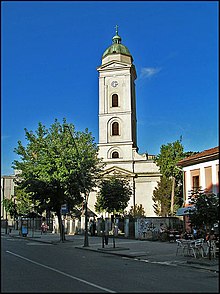


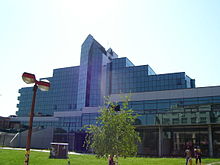
Šabac (Serbian Cyrillic: Шабац, Template:IPA-sh) is a city in western Serbia, along the Sava river, in the region of Mačva. It is the administrative center of the Mačva District. The city has a population of 52,822 (2011), while population of the administrative area is 115,347. Šabac acquired city rights in 2007, after a partial restructuring of local government in Serbia.
Name
The etymology of name Šabac is uncertain, although its resemblance to the name of the Sava River is suggestive. This name is in use since the end of the 15th century. In Serbian, the town is known as Šabac (Шабац), in Bosnian as Šabac, in Turkish as Böğürdelen, in German as Schabatz, and in Hungarian as Szabács.
History
Human settlements existed in this area in neolithic times. In the Middle Ages, Slavic settlement named Zaslon existed at the current location of Šabac. This settlement was firstly mentioned in Ragusan documents from 1454. It was part of the Serbian Despotate until it fell to the Ottoman Empire in 1459.
In 1470, the Ottomans built the first fortress in the town and named it Bejerdelen (Böğürdelen, meaning "side-striker"). In 1476 the Hungarian king Matthias captured the fort and it remained under administration of the Kingdom of Hungary till 1521, when it was again captured by the Ottoman Empire. During Hungarian administration, the town was part of the Banovina of Mačva and during Ottoman administration it was firstly part of the Sanjak of Zvornik within the Province of Bosnia, and later part of the Sanjak of Smederevo. Šabac was administrative center of the Nahija of Šabac, a local Ottoman administrative unit. In Ottoman period, Šabac was typical oriental town with tiny streets, small shops and several mosques. Population was composed of both, Muslims and Serbs.
Until the 19th century, Šabac was mostly under Ottoman administration, but control of the town also changed hands several times between the Ottoman Empire and Habsburg Monarchy. In the first period of Habsburg administration (1718-1739), Šabac was part of the Habsburg Kingdom of Serbia. After the Treaty of Belgrade (1739), Šabac was again included into Ottoman Empire and, due to the newly established border line between the two empires, it also became a border town, as well as important market town. A second period of Habsburg control of the area occurred in 1789-1790, the storming of the city being one of the early experiences of the renowned military leader Józef Poniatowski, but the Ottoman control over area was subsequently restored.
Šabac became a site of importance in Serbian history in the First Serbian Uprising when, in 1806, Karađorđe Petrović led the Serbian insurgents into one of the first victories over the Ottoman army near the nearby village of Mišar. Until 1813, the town was part of Karađorđe's Serbia. After the fall of Serbia in 1813, brief period of restored Ottoman control followed, but after the Second Serbian Uprising in 1815, Šabac was included into autonomous Principality of Serbia. However, Ottoman army remained in the Šabac fort for next several decades. The Obrenović family also left a mark on the town as the place of residence of the enlightened Jevrem Obrenović, brother of Prince Miloš Obrenović, who modernized and urbanized it after the Second Serbian Uprising. The period from 1820-1850 saw the establishment for the first time in Šabac of a hospital, a pharmacy, a Serbian grammar school, a gymnasium, a theatre, and a musical society.
The Ottoman army evacuated the fort of Šabac for good in 1867, marking the end of the Ottoman presence in the area. The first newspaper in the Kingdom of Serbia was printed in Šabac in 1883, and the town was also the first in Serbia where women started visiting kafanas (pubs) on Sunday afternoons, as was customary for men. The town prospered until the First World War when it was occupied and devastated by Austro-Hungarian army and had its population halved (from cca. 14,000 to 7,000). The World War I is also remembered for the battle on nearby Cer mountain where the Serbian army under general Stepa Stepanović won an early victory against Austria-Hungary in August 1914, the first Allied victory in the war. After the war, Šabac was decorated with French War Cross with Palm (1920), Czechoslovak War Cross (1925), and the Order of the Karađorđe's Star with Swords (1934).
Since 1918, the town is part of the newly formed Kingdom of Serbs, Croats and Slovenes (later renamed to Yugoslavia). From 1918 to 1922, it was administrative seat of Podrinje District, from 1922 to 1929 administrative seat of Podrinje Oblast, and from 1929 to 1941 it was part of the Drina Banovina. An early milestone in the Yugoslav era of the town's history was the opening of the Zorka chemical plant in 1938. The city's renewal was interrupted by World War II and occupation by German troops (from 1941 to 1944). During the German occupation, Šabac was part of the area governed by the Military Administration in Serbia. Some 5,000 residents of Šabac were imprisoned along with 20,000 others in the Šabac concentration camp; eventually, 7,000 of the inmates met their deaths. The city was liberated from occupation by the Yugoslav Partisans in 1944. After the war, it was included into People's Republic of Serbia within new socialist Yugoslavia. Since then, it grew into a modern industrial city with the aforementioned Zorka chemical plant and the expanded population. The 1970s saw the construction of the first modern sports hall. The swamp at the city's outskirts, Benska Bara, was drained and turned into a residential neighborhood, and a new bridge was built over the Sava river. As of 2010, the population of the city and its suburbs has risen to 75,000.
Demographics (2002 census)
| This article needs to be updated. Please help update this section to reflect recent events or newly available information. (November 2011) |
| Group | Population |
|---|---|
| Serbs | 118,178 |
| Roma | 1,001 |
| Muslims by nationality | 512 |
| Yugoslavs | 478 |
| Croats | 417 |
| Group | Population |
|---|---|
| Serbs | 52,499 |
| Roma | 151 |
| Muslims by nationality | 489 |
| Yugoslavs | 374 |
| Croats | 107 |
Local communities
Urban local communities
- Benska Bara
- Bair
- Kasarske livade
- Donji Šor
- Žika Popović
- Jevremova Nikole
- Trkalište
- Kamičak
- Kamenjak
- Letnjikovac
- Preki Šor
- Šipurske Livade
- Zivinarnik
Rural local communities

Economy
Prior to 1990, Šabac had one of the best developed economies in Yugoslavia. International sanctions against Yugoslavia during Bosnian War provoked the shutdown of the Zorka plant, which was the main enterprise in Šabac. Many other major local firms like "Šapčanka", "Izgradnja", and "Nama" also shut down during this period. The main industries of Šabac today are agriculture, transportation and food production. Since 2000, some of the more important companies are Šabačka Mlekara (dairy plant), Narcis Popović, Zorka Pharma, and US Steel.
| Activity | Number |
|---|---|
| Communal, public and personal service | 631 |
| Healthcare and social work | 2548 |
| Education | 1628 |
| Administration and social assurance | 724 |
| Property stock and charter | 419 |
| Finance | 272 |
| Traffic, storage and communication | 1670 |
| Hotels and restaurants | 394 |
| Wholesale and retail, repair | 2515 |
| Architecture | 981 |
| Distribution of power, gas and water | 655 |
| Salvage industry | 6880 |
| Mining | 52 |
| Fishing, agriculture and forestry | 540 |
Sport
There are several sports societies in Šabac:
- Kayak club "Zorka color" Šabac
- FK Mačva Šabac
- RK Metaloplastika
- Basketball club Šabac
- Waterpoolo club Šabac
- Boxing club Šabac
- Female handball club Medicinar
Local media
Radio stations
|
TV stations
|
Newspapers
|
Education

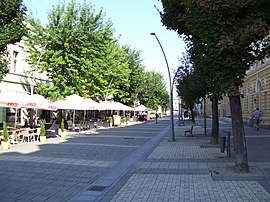
Elementary schools
This is a list of elementary schools in Šabac.
- OŠ "Sele Jovanović"
- OŠ "Nikolaj Velimirović" (official web site)
- OŠ "Vuk Karadzić"
- OŠ "Stojan Novaković"
- OŠ "Nata Jeličić"
- OŠ "Janko Veselinović"
- OŠ "Laza Lazarević"
High schools
This is a list of high schools in Šabac.
- Šabačka gimnazija (Šabac Grammar School)
- High agriculture school
- High medicine school "Dr Andra Jovanović"
- High economical-commercial school
- High chemical and textile school
- High technical school
- High music school Mihailo Vukdragović
- High art school
Private centres of education
- King's College
- Premier
- Pygmalion
- Interlink
Teachers' associations
Several teachers' associations exist in Šabac.
Transportation
Roads
The length and status of roads in the municipality is:
- Main roads 59.9 km (all asphalt)
- Regional roads 111.4 km (all asphalt)
- Local roads 304.2 km (187.8 km asphalt)
- Unconventional roads 2700 km (only 20 km asphalt)
- City streets 105 km
Railway
The railroad through Šabac connects Ruma (corridor X) and across Šabac, Loznica and Zvornik proceed Drina and connect Serbia with Bosnia and Herzegovina. A branch which connected this line with Bogatić (Petlovača - Bogatić) is locked out. The railway is used only for the transport of goods and raw materials for the Zorka factory.
Politics
Seats in the municipality parliament won in the 2004 local elections:
- Democratic Party - Serbian Renewal Movement (25)
- Serbian Radical Party (13)
- Democratic Party of Serbia (11)
- Socialist Party of Serbia (8)
- Serbian Strength Movement (6)
- G17 Plus (4)
- People's Peasant Party (2)
- Group of the citizens "The voice of the people" (2)
Non-government organizations in Šabac
According to unofficial data, in the city of Šabac, there are over 300 registred non-government organizations, with wide variety of activities and different primary goals. Traditionally, the most active are those organizations whose primary goals are humanitarian, protection of the rights of persons with disabilities, protection of the rights of ethnic minorities, protection of the vulnerable social categories, ecology, etc.
Beside traditionally active organizations in Šabac, there are non-government organizations which unites young people in purpose of protecting their own rights. Under the social category of youth (young people) are those who are not older than 30, and not younger than 15 years, according to Ministry (Department) of youth and sports, of the Republic of Serbia.
Some of the most active organizations in Šabac are: Youth Umbrella (Omladinski Kišobran), Caritas - Šabac, Roma for Roma, Human heart of Šabac (Humano srce Šapca), NGO Light, NGO Ecos.
Trade Unions
Famous people linked to Šabac

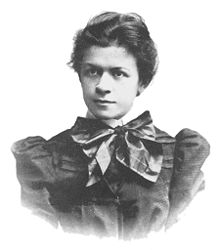

- Mileva Marić - Einstein
- Józef Poniatowski
- Jevrem Obrenović
- Stojan Novaković
- Milić Stanković
- Kosta Abrašević
- Ljubiša Jovanović
- Vladimir Jovanović
- Antun Gustav Matoš
- Dragiša Penjin
- Krstivoje Ilić
- Branimir Ćosić
- Andra Jovanović
- Robert Tolinger
- Janko Veselinović
- Laza Lazarević
- Đorđe Nešić
- Vladimir Stanimirović
- Šaban Šaulić
- Aleksandra Radović
- Ana Bekuta
- Milan Đenadić
- Ognjen Amidžić
- Nikola Grubješić
- Slavica Ćukteraš
- Miroslav Đukić
- Veselin Vujović
- Mile Isaković
- Ljuba Aličić
- Rade Lacković
- Dušan Petrović
- Goblini
- Eleven
- Branimir Đokić
- Zoran R. Gajic
- Branislav Lečić
- Aleksandar Rašić
- Avram Josif Vinaver and Stanislav Vinaver
Coat of arms of Šabac and armorial flag
There are three versions of the coat of arms of Šabac: the Primary, Middle, and Large.
-
 Primary coat of arms
Primary coat of arms
- Middle coat of arms Middle coat of arms
-
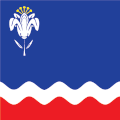 Šabac Armorial flag
Šabac Armorial flag
Twin cities
Šabac is twinned with the following cities:
References
Footnotes
- ^ http://www.sabac.org/index_srb.php?page=12
- http://www.kingscollege.rs/
- http://www.premiercentar.com/
- http://www.pygmalion.edu.rs/
- List of Affiliation Partners within Prefectures - Saitama Prefecture


